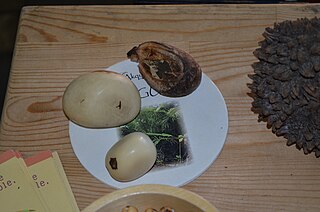
Vegetable ivory or tagua nut is a product made from the very hard white endosperm of the seeds of certain palm trees. Vegetable ivory is named for its resemblance to animal ivory. Vegetable ivory is naturally white with a fine marbled grain structure. It can be dyed; dyeing often brings out the grain. It is still commonly used in buttons, jewelry, and artistic carving.

Mauritia flexuosa, known as the moriche palm, ité palm, ita, buriti, muriti, miriti (Brazil), canangucho (Colombia), morete or acho (Ecuador), or aguaje (Peru), is a palm tree. It grows in and near swamps and other wet areas in tropical South America.

The palm tree Phytelephas aequatorialis, commonly known as Ecuadorian ivory palm, is the main source of Ecuadorean vegetable ivory or tagua, a botanical alternative to ivory. It is found in the tropical rainforests of the western Andean slopes of Ecuador. It has a woody trunk which can grow to 20 m in height and very long pinnate leaves.

Tumaco is a port city and municipality in the Nariño Department, Colombia, by the Pacific Ocean. It is located on the southwestern corner of Colombia, near the border with Ecuador, and experiences a hot tropical climate. Tumaco is inhabited mainly by Afro-Colombians and some indigenous people.

Phytelephas is a genus containing six known species of dioecious palms, occurring from southern Panama along the Andes to Ecuador, Bolivia, Colombia, northwestern Brazil, and Peru. They are commonly known as ivory palms, ivory-nut palms or tagua palms ; the scientific name Phytelephas means "plant ivory" or more literally, "plant elephant". This and the first two of the common names refer to the very hard white endosperm of their seeds, which resembles elephant ivory.
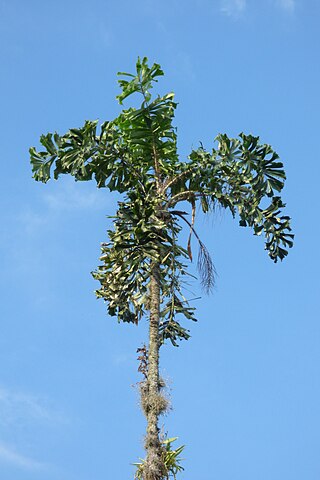
Aiphanes horrida is a palm native to northern South America and Trinidad and Tobago. Aiphanes horrida is a solitary, spiny tree. In the wild it grows 3–10 metres tall tall with a stem diameter of 6–10 centimetres ; cultivated trees may be as much as 15 m (49') tall with a 15 cm (6") diameter. The epicarp and mesocarp of the fruit are rich in carotene and are eaten in Colombia, while the seeds are used to make candles. In parts of the Colombian Llanos, endocarps are used to play games.

Oenocarpus is a genus of pinnate-leaved palms (Arecaceae) native to Trinidad, southern Central and tropical South America. With nine species and one natural hybrid, the genus is distributed from Costa Rica and Trinidad in the north to Brazil and Bolivia in the south.

Cachipay is a municipality and town of Colombia in the Tequendama Province, part of the department of Cundinamarca. Cachipay borders Quipile in the west, Zipacón in the east, Anolaima in the north and La Mesa in the south. The urban centre is located 53 kilometres (33 mi) east of Bogotá.

Phytelephas seemannii, commonly called Panama ivory palm, is a species of flowering plant in the family Arecaceae. It is one of the plants used for vegetable ivory.
Phytelephas tumacana is a species of palm tree. It is endemic to Colombia, where it grows in forests near rivers. It is threatened by the destruction of habitat for agriculture.
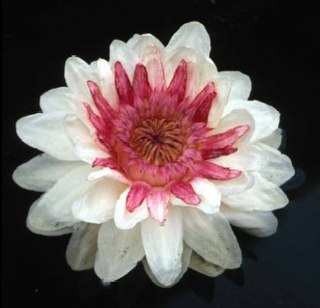
The Flora of Colombia is characterized by over 32,000 species of green plants.

Aphandra is a monotypic genus of flowering plants in the palm family native to the Amazon rainforest vegetation in South America. Its only species is Aphandra natalia, sometimes called mastodon palm or fiber palm, and is used by indigenous peoples in the construction of brooms and other products. This plant is commercially exploited for its edible fruits, and for its leaf sheath and petiole fibers. This fiber is almost equal to the fiber extracted from Attalea funifera and Leopoldinia piassaba, which is called piassava.

Ammandra is a monotypic genus of flowering plants in the palm family found in Colombia and Ecuador, where it is endangered. The sole species is Ammandra decasperma, although another species name has been proposed. It is a pinnate-leaved, dioecious palm whose seeds and petioles are used in button and basket making, respectively. It is commonly called ivory palm or cabecita.

Attalea cohune, commonly known as the cohune palm, is a species of palm tree native to Mexico and parts of Central America.

Psorothamnus schottii is a species of flowering plant in the legume family known by the common name Schott's dalea. It is native to the Sonoran Deserts of northern Mexico and adjacent sections of Arizona and the Colorado Desert in California.

Yucca × schottii is a plant species in the genus Yucca, native to southern Arizona, southwestern New Mexico, and the northern parts of Sonora and Chihuahua. The common names are Schott's yucca, hoary yucca, and mountain yucca. The "×" in the name indicates that this is a nothospecies, regarded as being a natural hybrid between two other species. In this case, Yucca × schottii is believed to have originated as a hybrid between Y. baccata and Y. madrensis. Yucca × schottii is firmly established and does reproduce freely in the wild.
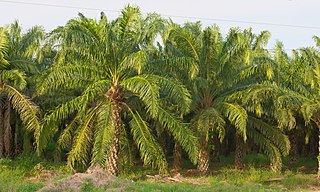
Elaeis oleifera is a species of palm commonly called the American oil palm. It is native to South and Central America from Honduras to northern Brazil.

Phytelephas macrocarpa is a single-stemmed, unarmed, reclining or erect palm from the extreme northern coastal regions of South America, growing to some 12 m tall. It has been introduced and cultivated in tropical regions all over the world. The trunk is about 30 cm across, with prominent leaf scars. The crown is made up of about 30 plume-like leaves or fronds, each about 8 m long, dead leaves being persistent. It is one of some 7 species of palm in the genus Phytelephas, all of which have been exploited for vegetable ivory or tagua from the seed or corozo nut. The closely related Ammandra decasperma from Colombia, and Aphandra natalia from Ecuador, are also sources of vegetable ivory, but of inferior quality and therefore not commercially significant. 'Phytelephas macrocarpa' translates to ‘elephant plant’ with 'large fruit', the endosperm of the nut having the texture of elephant ivory, and consisting of large, thick-walled cells of two long-chain polysaccharides, mannan A and B.
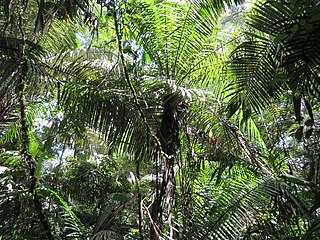
Phytelephas tenuicaulis is a species of palm in the genus Phytelephas. The compound leaves are around 7 meters in length, with stem diameters of 10 cm. Brown, ovulate fruits of about 6 cm are produced. Palms of the Phytelephas genus are also referred to as vegetable ivory palms.

















